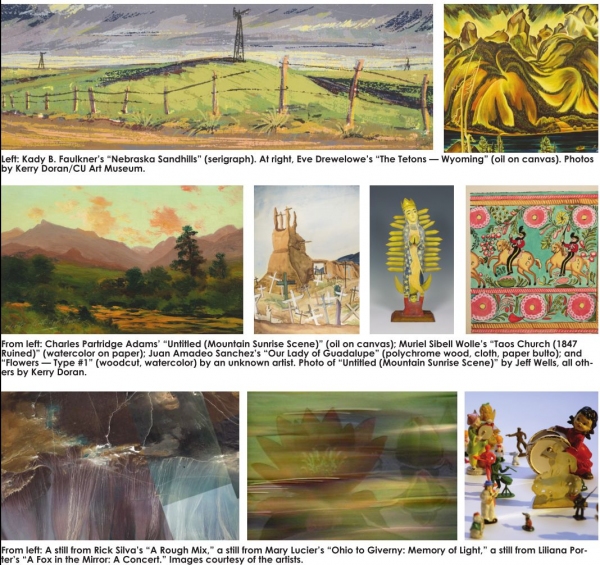
So much of art is a reflection of the time period in which it was created, and two new, very different exhibitions at the University of Colorado Art Museum, American West and Interlaced, demonstrate that point very clearly.
American West features paintings from the late 19th and early 20th century, while Interlaced shows contemporary videos, mostly from the past 10 years. The historical events of both time periods come out through the art to give spectators a grasp of the artist’s view on society now versus a hundred years ago.
“I think they both worked out really well next to each other as kind of a then-and-now parallel,” says Sarah Diver, curatorial assistant for the museum.
The paintings in American West portray farmers branding cattle on a ranch, an array of landscapes from mountains to flowers and portraits of different Native American tribe members.
“A lot of [artists] were interested in capturing a spirit of the American landscape and really putting a visual language to what had been happening around that time,” Diver says.
One of the artists displayed, Muriel Sibell Wolle, a former writer and art collector, donated many of the paintings in the CU Art Museum’s permanent collection. She was chair of the fine arts department at CU for decades in the early 20th century.
Wolle, a Brooklyn native, moved to Colorado to teach at CU and soon developed a deep love for the land and its history. She spent a lot of her time in mountain towns and wrote multiple books, such as The Bonanza Trail, about the gold and silver mining history in Colorado.
“While she was department chair here she would go almost every weekend with her students in this little Jeep in these rugged back roads and sketch what she saw and take notes,” Diver says.
The black-and-white sketches from Wolle’s weekend trips have harsher lines and are more life-like than her colored paintings, which have more neutral tones and soft edges.
The work of other artists who spent time with the Zuni tribe and in the Navajo Nation are on display, as well as some paintings of religious iconography from New Mexico. William Pennington’s posed photos of the Navajo show them dressed in tribal cloth and holding weapons.
Some of the artwork dates to the Works Progress Administration (WPA) under President Franklin D. Roosevelt’s New Deal, when artists made prints of scenes of New Mexico.
“This portfolio of Spanish colonial design goes to show how thorough and investigative a lot of these [WPA] artists were, and how it’s more than just documenting the visual qualities of the [religious] statues,” Diver says.
A group of paintings done by one anonymous Mexican artist shows the representations of images that the artist saw on a painted wooden chest.
The chest paintings have two themes, a scene of people with horses and buildings, and an all-over floral design with an object in the center.
The second exhibition, Interlaced, contains recent contemporary film and video works, the oldest one dating back to 1968. (The term “interlaced” comes from a technological term that describes how some video cameras process images.)
“I think is an important contemporary art; it’s from our time,” Diver says.
The first video in the exhibition is Tongue Twister Variations, directed by Dan Boord and Luis Valdovino. They videotaped people all over the world saying a tongue twister in their native language, and then showed the clips with English subtitles below them. The consistent rhythm of the tongue twisters makes the video poetic to listen to, even though the language is foreign.
In the same way that American West highlights issues relevant during the New Deal era, Interlaced sheds light on the environmental issues the world is currently facing.
Rick Silva, an assistant professor at the University of Oregon, created a piece, “A Rough Mix,” where he brings an instrument into different types of terrain and acts like a DJ — scratching and mixing with earth elements instead of albums. He uses his hand to move around sand and snow, and brushes against trees and bushes. The sounds of the video change depending on the element he uses.
“It’s really manic to watch. It kind of has that imminent, immediate feeling to it. I have a hard time looking at it for a while; I think that’s kind of the point,” Diver says.
Bruce Nauman’s “Slow Angle Walk,” is a 1968 black-and-white film, and the oldest work in Interlaced. Nauman filmed the piece in his studio and used the idea that anything he creates in his studio must be art. He turned a camera onto its side and filmed him walking around his studio. His goal was to investigate film’s ability to alter the viewer’s spatial orientation.
“Playing with this disorienting feeling of standing on one leg, it looks like he should fall back, but he doesn’t,” Diver says.














